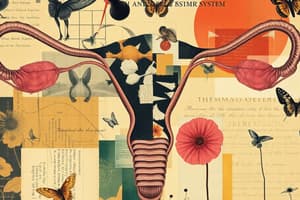Podcast
Questions and Answers
¿Cuál es la fórmula para calcular el área de un triángulo?
¿Cuál es la fórmula para calcular el área de un triángulo?
- $base \times altura$
- $\frac{1}{2} \times base \times altura$ (correct)
- $\frac{1}{2} \times base \times base$
- $2 \times base \times altura$
Si el perímetro de un cuadrado es de 20 cm, ¿cuál es la longitud de uno de sus lados?
Si el perímetro de un cuadrado es de 20 cm, ¿cuál es la longitud de uno de sus lados?
- 5 cm (correct)
- 40 cm
- 10 cm
- 20 cm
¿Cuál es la fórmula para calcular el volumen de un cubo?
¿Cuál es la fórmula para calcular el volumen de un cubo?
- $\pi \times lado \times lado$
- $lado \times lado \times lado$ (correct)
- $lado \times lado$
- $\frac{1}{3} \times lado \times lado \times lado$
Si el radio de un círculo es de 5 cm, ¿cuál es su diámetro?
Si el radio de un círculo es de 5 cm, ¿cuál es su diámetro?
Un triángulo rectángulo tiene un ángulo recto de 90 grados. ¿Cuál es la suma de los otros dos ángulos?
Un triángulo rectángulo tiene un ángulo recto de 90 grados. ¿Cuál es la suma de los otros dos ángulos?
Flashcards
Descargas
Descargas
Acto de obtener contenido de internet.
Contenido
Contenido
Información cargada o descargada de internet.
Estudiar
Estudiar
Práctica de revisar información para aprender.
Sitio web
Sitio web
Signup and view all the flashcards
Protocolo de descarga
Protocolo de descarga
Signup and view all the flashcards
Study Notes
Reproduction in General
- Reproduction is the key process for the continuation of life on Earth.
- All other bodily systems support reproduction.
- This chapter covers human reproductive systems, important for examinations.
- Key components include structures, fertilization, and placental functions.
Reproduction Patterns
- Asexual reproduction: Reproductive units may be any part of the parent organism, ranging from a whole body to a small fragment.
- Examples: Budding in hydra, fission in bacteria and yeast, vegetative reproduction in plants.
- Sexual reproduction: Involves specialized sex cells (gametes).
- Gametes: Sperm (male) and egg (female).
- Fertilization: Fusion of sperm and egg to form a zygote, the first cell of a new individual.
- Difference between asexual and sexual reproduction: Asexual reproduction produces offspring that are genetically identical to the parent, while sexual reproduction involves the mixing of genetic material resulting in increased variation.
Human Reproductive Systems - Male
- Primary reproductive organs: Testes (singular: testis).
- Testes Location: Located in a sac called the scrotum, outside the body. This lower temperature allows for proper sperm development and maturation.
- Testes Structure: Each testis is composed of many lobules containing seminiferous tubules where sperm production occurs (spermatogenesis).
- Interstitial cells: Produce testosterone, the male sex hormone.
- Accessory reproductive organs: Sperm ducts (vas deferens), accessory glands (seminal vesicles, prostate, and bulbourethral glands), and the penis.
- Sperm ducts: Transport sperm.
- Accessory glands: Produce fluids that nourish and protect sperm.
- Penis: Deliver sperm to the female reproductive tract.
- Temperature regulation: Spermatogenesis needs a specific temperature. The scrotum adjusts its position to regulate this temperature.
Human Reproductive Systems - Female
- Primary reproductive organs: Ovaries.
- Ovaries: Produce ova (female gametes) and hormones such as estrogen and progesterone.
- Oogenesis: The process of ova production.
- Ova: The mature female gametes.
- Oviducts: Transport eggs or ova from the ovaries to the uterus.
- Uterus: A pear-shaped organ that holds the developing embryo/fetus and provides a nurturing environment during pregnancy.
- Vagina: The muscular tube that receives sperm and allows childbirth.
- External genitalia: Vulva, clitoris, labia.
- Menstrual cycle: Controlled by hormones, preparing the uterus for a potential pregnancy.
- Ovulation: Release of the egg from the ovary.
Placenta
- The placenta is a disc-like structure that attaches to the uterine wall.
- It enables the exchange of essential materials between the mother and the developing embryo/fetus.
- Oxygen and nutrients pass from the mother's blood to the embryo/fetus.
- Waste products (carbon dioxide, urea) from the embryo/fetus diffuse into the mother's blood.
- It also produces hormones that help maintain the pregnancy.
Fertilisation
- The process of fertilization takes place in the fallopian tubes.
- Fertilization happens when the sperm and egg meet and fuse, producing a zygote.
- The zygote develops into an embryo, and eventually a fetus.
Stages of Pregnancy and Birth
- Gestation period: The duration of pregnancy.
- Parturition: The process of childbirth.
- Stages in development of embryo: Zygote, morula, blastocyst, embryo, fetus.
- Growth of embryo in uterus: Stages and development in the uterus.
- Placenta: The link between the mother and the growing fetus.
Twins
- Fraternal twins: Formed from two separate eggs fertilized by two different sperms.
- Identical twins: Formed from a single egg that divides early in pregnancy.
Studying That Suits You
Use AI to generate personalized quizzes and flashcards to suit your learning preferences.




